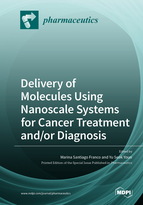Delivery of Molecules Using Nanoscale Systems for Cancer Treatment and/or Diagnosis
A special issue of Pharmaceutics (ISSN 1999-4923). This special issue belongs to the section "Drug Delivery and Controlled Release".
Deadline for manuscript submissions: closed (10 December 2021) | Viewed by 39980
Special Issue Editors
2. Department of Radiation Oncology, School of Medicine, Technical University of Munich (TUM), Klinikum rechts der Isar, 81675 Munich, Germany
Interests: cancer; drug delivery; nanosystems; liposomes; chemotherapy; radiotherapy; microbeams; abscopal effect
Special Issues, Collections and Topics in MDPI journals
Special Issue Information
Dear Colleagues,
Since the clinical approval of the first liposomal formulation encapsulating a chemotherapeutic agent, nanoscale delivery systems designed for cancer treatment and diagnosis are a rapidly developing science. This delivery strategy is evolving and more recently, the co-delivery of anticancer agent combinations allows the targeting of different pathways, genes, or cell cycle checkpoints so that resistance to single agents can be overcome. Multiple studies in this field have shown the potential of simultaneous release of different agents to the tumor site. Not only that, but also the possibility to control the delivered ratios of these agents, improving synergistic antitumor effects. Meanwhile, the co-delivery of an anticancer agent and a medical imaging agent allows simultaneous cancer therapy and imaging, significantly improving cancer management. These approaches are often further combined to strategies such as active targeting or triggered delivery, culminating in highly multifunctional nanoscale systems.
This Special Issue will highlight current advances and challenges in the broad theme of nanosystem development for the delivery of molecules to treat and/or diagnose tumors. We encourage the submission of focused review manuscripts as well as original research concerning in vitro, in vivo, and translational studies.Dr. Marina Santiago Franco
Prof. Dr. Yu Seok Youn
Guest Editors
Manuscript Submission Information
Manuscripts should be submitted online at www.mdpi.com by registering and logging in to this website. Once you are registered, click here to go to the submission form. Manuscripts can be submitted until the deadline. All submissions that pass pre-check are peer-reviewed. Accepted papers will be published continuously in the journal (as soon as accepted) and will be listed together on the special issue website. Research articles, review articles as well as short communications are invited. For planned papers, a title and short abstract (about 100 words) can be sent to the Editorial Office for announcement on this website.
Submitted manuscripts should not have been published previously, nor be under consideration for publication elsewhere (except conference proceedings papers). All manuscripts are thoroughly refereed through a single-blind peer-review process. A guide for authors and other relevant information for submission of manuscripts is available on the Instructions for Authors page. Pharmaceutics is an international peer-reviewed open access monthly journal published by MDPI.
Please visit the Instructions for Authors page before submitting a manuscript. The Article Processing Charge (APC) for publication in this open access journal is 2900 CHF (Swiss Francs). Submitted papers should be well formatted and use good English. Authors may use MDPI's English editing service prior to publication or during author revisions.
Keywords
- delivery
- nanosystems
- cancer
- combination chemotherapy
- anticancer agents
- co-encapsulation
- ratiometric drug delivery
- synergism
- cancer diagnosis
- imaging agents
- theranostics








